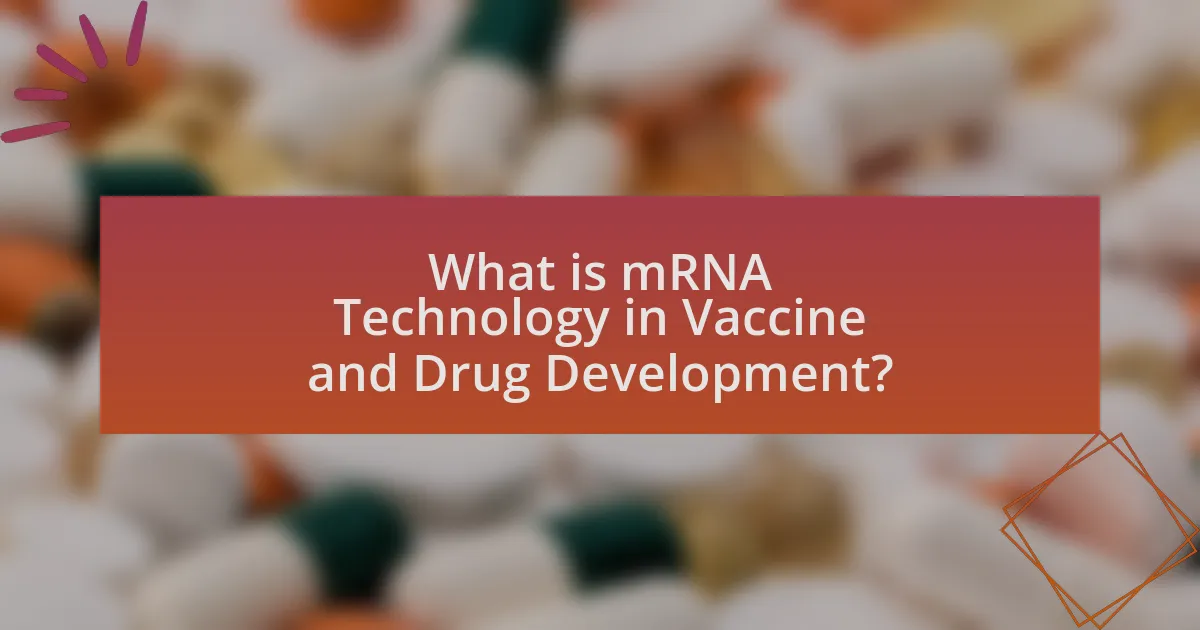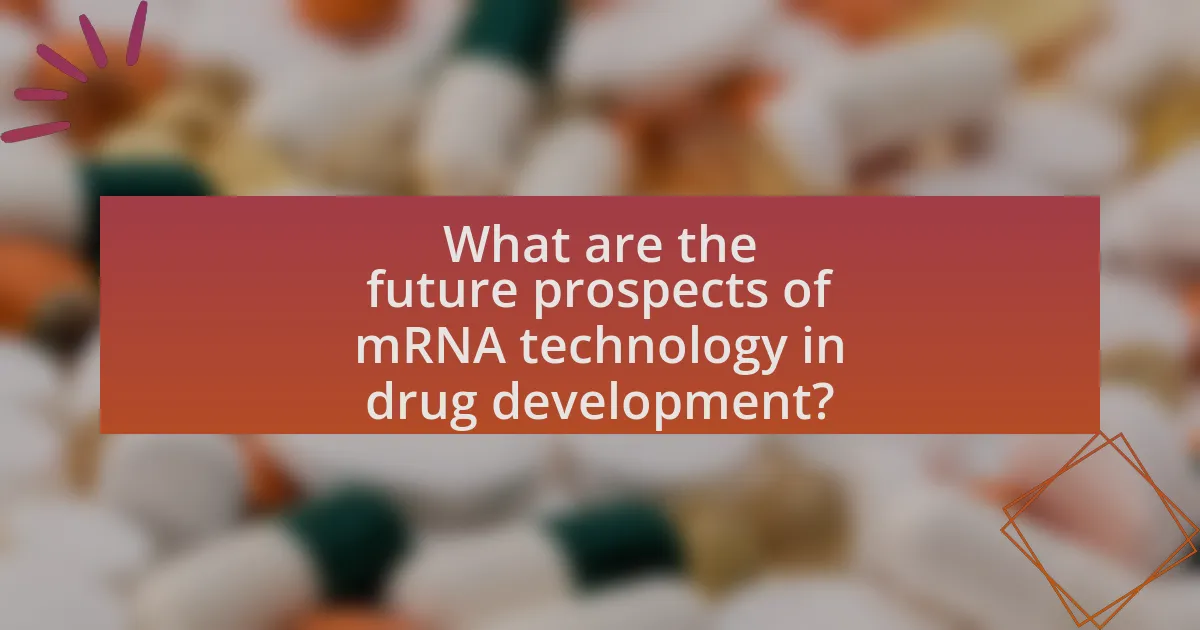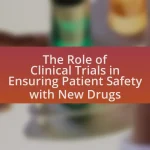The article focuses on mRNA technology and its transformative role in vaccine and drug development. It outlines how mRNA vaccines, such as those developed by Pfizer-BioNTech and Moderna for COVID-19, utilize synthetic messenger RNA to instruct cells to produce proteins that elicit immune responses. Key components, delivery mechanisms, historical milestones, and the advantages of mRNA technology over traditional methods are discussed, along with its potential applications in treating diseases beyond infectious ones, including cancer and genetic disorders. The article also addresses challenges, regulatory hurdles, and the importance of collaboration among stakeholders to advance mRNA research and innovation.
What is mRNA Technology in Vaccine and Drug Development?

mRNA technology in vaccine and drug development involves the use of messenger RNA to instruct cells to produce proteins that can trigger an immune response or treat diseases. This innovative approach allows for rapid development and production of vaccines, as seen with the COVID-19 vaccines from Pfizer-BioNTech and Moderna, which were developed in record time using mRNA technology. The effectiveness of these vaccines, demonstrated by their ability to elicit strong immune responses and reduce severe illness, showcases the potential of mRNA technology in addressing various infectious diseases and even cancer therapies.
How does mRNA technology function in the context of vaccines?
mRNA technology functions in vaccines by using synthetic messenger RNA to instruct cells to produce a harmless piece of the target pathogen, typically a protein. This protein then triggers an immune response, allowing the body to recognize and fight the actual pathogen if encountered in the future. For example, the Pfizer-BioNTech and Moderna COVID-19 vaccines utilize this technology to encode the spike protein of the SARS-CoV-2 virus, leading to the production of antibodies and T-cell responses that provide immunity. Studies have shown that these vaccines are highly effective, with efficacy rates exceeding 90% in preventing symptomatic COVID-19, demonstrating the successful application of mRNA technology in vaccine development.
What are the key components of mRNA vaccines?
The key components of mRNA vaccines are messenger RNA (mRNA), lipid nanoparticles, and various stabilizers. The mRNA serves as the blueprint for producing a specific protein, typically a spike protein from a virus, which triggers an immune response. Lipid nanoparticles encapsulate the mRNA, facilitating its delivery into human cells, while stabilizers help maintain the integrity of the mRNA during storage and transport. These components work together to ensure the vaccine effectively stimulates an immune response against the targeted pathogen.
How does the delivery mechanism of mRNA vaccines work?
The delivery mechanism of mRNA vaccines involves encapsulating the mRNA in lipid nanoparticles, which facilitate its entry into human cells. These lipid nanoparticles protect the fragile mRNA from degradation and enable it to fuse with the cell membrane, allowing the mRNA to be released into the cytoplasm. Once inside, the mRNA is translated by the cell’s ribosomes into the target protein, typically a piece of the virus, which then triggers an immune response. This method has been validated by the successful deployment of mRNA vaccines, such as those developed by Pfizer-BioNTech and Moderna, which have shown efficacy rates exceeding 90% in preventing COVID-19.
What are the historical milestones in mRNA vaccine development?
The historical milestones in mRNA vaccine development include the discovery of mRNA in the early 1960s, the first successful use of mRNA in vaccines during the COVID-19 pandemic, and the establishment of mRNA as a viable platform for rapid vaccine development. In 1961, researchers identified messenger RNA as a key component in protein synthesis, laying the groundwork for future applications. The first mRNA vaccine, developed by BioNTech and Pfizer, received emergency use authorization in December 2020, demonstrating the technology’s effectiveness against SARS-CoV-2. This rapid development showcased mRNA’s potential for quick adaptation to emerging infectious diseases, marking a significant advancement in vaccine technology.
How did the COVID-19 pandemic accelerate mRNA technology adoption?
The COVID-19 pandemic accelerated mRNA technology adoption by demonstrating its rapid development and efficacy in vaccine production. The urgent need for a vaccine against SARS-CoV-2 led to unprecedented collaboration among pharmaceutical companies, researchers, and governments, resulting in the first mRNA vaccines, such as Pfizer-BioNTech and Moderna, being authorized for emergency use within a year of the virus’s emergence. This swift timeline showcased mRNA’s potential for quick adaptation to emerging pathogens, significantly increasing interest and investment in mRNA technology for future vaccines and therapeutics. The success of these vaccines has prompted further research and development in mRNA applications beyond infectious diseases, including cancer and genetic disorders, solidifying its role in the future of vaccine and drug development.
What lessons were learned from early mRNA vaccine trials?
Early mRNA vaccine trials demonstrated the importance of rapid development and adaptability in vaccine technology. These trials highlighted that mRNA vaccines could be designed and produced quickly in response to emerging infectious diseases, as evidenced by the swift development of the Pfizer-BioNTech and Moderna COVID-19 vaccines within months of the virus’s identification. Additionally, early trials revealed the significance of robust safety monitoring and the need for clear communication regarding potential side effects, which helped build public trust. The trials also underscored the necessity of collaboration between public health agencies, regulatory bodies, and pharmaceutical companies to expedite vaccine approval processes while ensuring safety and efficacy.
What advantages does mRNA technology offer over traditional vaccine methods?
mRNA technology offers several advantages over traditional vaccine methods, primarily in speed, adaptability, and safety. Unlike conventional vaccines that often use weakened or inactivated pathogens, mRNA vaccines utilize synthetic messenger RNA to instruct cells to produce a harmless piece of the target virus, prompting an immune response. This approach allows for rapid development; for instance, the Pfizer-BioNTech and Moderna COVID-19 vaccines were developed and authorized for emergency use within months of the virus’s genetic sequence being identified. Additionally, mRNA vaccines can be easily modified to address emerging variants, enhancing their adaptability compared to traditional methods that may require more extensive changes. Furthermore, mRNA vaccines do not contain live virus, reducing the risk of vaccine-related infections, which is a concern with some traditional vaccines. These factors collectively demonstrate the significant advantages of mRNA technology in vaccine development.
How does mRNA technology enhance immune response?
mRNA technology enhances immune response by instructing cells to produce specific proteins that mimic pathogens, thereby triggering an immune reaction. This process allows the immune system to recognize and remember these proteins, leading to a more robust and rapid response upon actual exposure to the pathogen. For instance, the mRNA vaccines developed for COVID-19, such as those by Pfizer-BioNTech and Moderna, demonstrated efficacy rates exceeding 90% in preventing symptomatic infection, showcasing the technology’s ability to elicit strong immune responses.
What are the implications for speed and scalability in vaccine production?
The implications for speed and scalability in vaccine production are significant, particularly with the advent of mRNA technology. This technology allows for rapid development and manufacturing of vaccines, as seen during the COVID-19 pandemic, where mRNA vaccines were developed and distributed within a year. The scalability of mRNA platforms enables large-scale production, as demonstrated by companies like Moderna and Pfizer-BioNTech, which produced hundreds of millions of doses in a short timeframe. This efficiency is supported by the ability to quickly adapt mRNA sequences to target emerging pathogens, thereby enhancing public health responses to infectious diseases.
What are the future prospects of mRNA technology in drug development?

The future prospects of mRNA technology in drug development are highly promising, with potential applications extending beyond vaccines to treat various diseases, including cancer and genetic disorders. mRNA technology enables the rapid design and production of therapeutics, as evidenced by the swift development of COVID-19 vaccines, which utilized mRNA to elicit an immune response. Research indicates that mRNA can be engineered to produce therapeutic proteins in the body, offering a novel approach to treating conditions like cystic fibrosis and muscular dystrophy. Additionally, ongoing clinical trials are exploring mRNA-based cancer therapies that aim to stimulate the immune system to target and destroy cancer cells. The versatility and adaptability of mRNA technology position it as a transformative tool in the pharmaceutical landscape, with the potential to revolutionize how diseases are treated in the future.
How can mRNA technology be applied to treat diseases beyond infectious diseases?
mRNA technology can be applied to treat diseases beyond infectious diseases by enabling the development of personalized cancer therapies and addressing genetic disorders. This technology allows for the creation of mRNA molecules that instruct cells to produce specific proteins, which can trigger an immune response against tumors or replace defective proteins in genetic conditions. For instance, BioNTech and Moderna are exploring mRNA-based treatments for various cancers, demonstrating efficacy in clinical trials by inducing targeted immune responses. Additionally, research is underway to utilize mRNA for conditions like cystic fibrosis and muscular dystrophy, where the delivery of functional mRNA can potentially correct underlying genetic defects.
What potential does mRNA have in cancer treatment?
mRNA has significant potential in cancer treatment by enabling personalized cancer vaccines and targeted therapies. This technology allows for the development of vaccines that can stimulate the immune system to recognize and attack cancer cells specifically, as demonstrated in clinical trials where mRNA vaccines have shown promising results in eliciting strong immune responses against tumors. For instance, BioNTech’s mRNA-based personalized cancer vaccine has shown efficacy in patients with melanoma, leading to tumor regression in some cases. Additionally, mRNA can be utilized to encode for therapeutic proteins that can directly inhibit cancer cell growth, further enhancing treatment options.
How might mRNA technology revolutionize genetic disorders treatment?
mRNA technology has the potential to revolutionize the treatment of genetic disorders by enabling precise and targeted gene therapy. This approach allows for the direct delivery of mRNA that encodes functional proteins to replace or supplement defective genes, addressing the root cause of genetic disorders. For instance, clinical trials have demonstrated the efficacy of mRNA therapies in treating conditions like cystic fibrosis and muscular dystrophy, where the introduction of correct mRNA can restore normal protein function. Additionally, mRNA’s ability to stimulate the immune system can enhance the body’s natural response to genetic diseases, further improving treatment outcomes.
What challenges must be overcome for mRNA technology to reach its full potential?
mRNA technology must overcome several challenges to reach its full potential, including stability, delivery mechanisms, and regulatory hurdles. Stability issues arise because mRNA is inherently unstable and can degrade quickly in biological environments, necessitating the development of more robust formulations. Effective delivery mechanisms are crucial, as mRNA must be efficiently transported into cells without triggering adverse immune responses; advancements in lipid nanoparticles have shown promise in this area. Additionally, navigating regulatory frameworks is essential for the approval of mRNA-based therapies, which requires extensive clinical trials to demonstrate safety and efficacy. These challenges must be addressed to fully harness the capabilities of mRNA technology in vaccine and drug development.
What are the regulatory hurdles facing mRNA drug development?
Regulatory hurdles facing mRNA drug development include stringent safety and efficacy requirements, complex manufacturing standards, and the need for comprehensive clinical trial data. Regulatory agencies, such as the FDA, mandate extensive preclinical and clinical testing to ensure that mRNA therapies are safe for human use, which can prolong the development timeline. Additionally, the unique nature of mRNA technology necessitates specific guidelines for production and quality control, as outlined in the FDA’s guidance documents. These factors collectively contribute to the challenges in bringing mRNA drugs to market efficiently.
How can public perception and acceptance of mRNA technology be improved?
Public perception and acceptance of mRNA technology can be improved through transparent communication and education about its safety and efficacy. Engaging the public with clear, evidence-based information can demystify the technology, as studies have shown that informed individuals are more likely to support mRNA vaccines. For instance, a survey conducted by the Kaiser Family Foundation in 2021 indicated that understanding the science behind mRNA vaccines significantly increased acceptance rates among participants. Additionally, involving trusted community leaders in outreach efforts can enhance credibility and foster trust in the technology.
What role does collaboration play in advancing mRNA technology?
Collaboration plays a crucial role in advancing mRNA technology by facilitating knowledge sharing, resource pooling, and accelerating innovation. Collaborative efforts among academic institutions, biotechnology companies, and pharmaceutical firms have led to significant breakthroughs, such as the rapid development of mRNA vaccines for COVID-19. For instance, the partnership between BioNTech and Pfizer resulted in the first authorized mRNA vaccine, demonstrating how collaboration can expedite research and development processes. Additionally, collaborative networks enable access to diverse expertise and funding, which are essential for overcoming technical challenges and enhancing the scalability of mRNA production.
How can partnerships between academia and industry enhance mRNA research?
Partnerships between academia and industry can enhance mRNA research by facilitating the exchange of knowledge, resources, and technology. Academic institutions often possess cutting-edge research capabilities and theoretical insights, while industry partners provide practical applications, funding, and infrastructure. For instance, collaborations can lead to the rapid translation of laboratory discoveries into clinical applications, as seen in the development of mRNA vaccines during the COVID-19 pandemic, where academic research was swiftly integrated with industry manufacturing processes. This synergy not only accelerates innovation but also ensures that mRNA technologies are effectively optimized for real-world use, ultimately advancing vaccine and drug development.
What are the benefits of international collaboration in mRNA development?
International collaboration in mRNA development enhances innovation, accelerates research, and optimizes resource utilization. By pooling expertise and resources from various countries, researchers can share knowledge on mRNA technology, leading to faster advancements in vaccine and therapeutic development. For instance, the global response to the COVID-19 pandemic showcased how collaborative efforts among countries and institutions resulted in the rapid development and distribution of mRNA vaccines, such as those from Pfizer-BioNTech and Moderna. This collaboration not only facilitated the sharing of scientific data but also enabled the scaling of production capabilities, demonstrating that international partnerships can significantly improve the efficiency and effectiveness of mRNA-based solutions in public health.
How can stakeholders prepare for the future of mRNA technology?

Stakeholders can prepare for the future of mRNA technology by investing in research and development to enhance the efficacy and delivery mechanisms of mRNA vaccines and therapeutics. This preparation involves collaborating with biotech firms and academic institutions to advance the understanding of mRNA’s potential applications beyond infectious diseases, such as in cancer treatment and genetic disorders. For instance, the rapid development of mRNA vaccines during the COVID-19 pandemic demonstrated the technology’s scalability and adaptability, prompting stakeholders to focus on establishing robust supply chains and regulatory frameworks to facilitate future mRNA product approvals. Additionally, stakeholders should prioritize workforce training in mRNA technology to ensure a skilled labor pool capable of supporting ongoing innovations in this field.
What strategies should pharmaceutical companies adopt to leverage mRNA technology?
Pharmaceutical companies should adopt strategies that focus on research and development, collaboration, and regulatory engagement to leverage mRNA technology effectively. Investing in R&D allows companies to explore diverse applications of mRNA beyond vaccines, such as in cancer therapies and rare genetic disorders. Collaborating with academic institutions and biotech firms can enhance innovation and accelerate the development process, as seen in the rapid advancement of COVID-19 mRNA vaccines through partnerships between companies like Pfizer and BioNTech. Engaging with regulatory bodies early in the development process ensures compliance and facilitates smoother approval pathways, which is critical given the fast-paced nature of mRNA technology advancements.
How can companies invest in research and development for mRNA applications?
Companies can invest in research and development for mRNA applications by allocating funds to innovative projects, collaborating with academic institutions, and establishing partnerships with biotech firms. For instance, in 2021, Moderna allocated over $1 billion to expand its mRNA platform, demonstrating a commitment to advancing mRNA technology. Additionally, companies can engage in clinical trials to test new mRNA therapies, as seen with Pfizer’s investment in its mRNA vaccine development, which has yielded significant advancements in vaccine efficacy. By focusing on these strategies, companies can enhance their capabilities in mRNA research and development.
What best practices should be followed for clinical trials involving mRNA products?
Best practices for clinical trials involving mRNA products include rigorous preclinical testing, adherence to regulatory guidelines, and comprehensive participant monitoring. Rigorous preclinical testing ensures safety and efficacy before human trials, as demonstrated by the successful development of mRNA vaccines for COVID-19, which underwent extensive animal studies prior to human trials. Adherence to regulatory guidelines, such as those set by the FDA and EMA, is crucial for maintaining compliance and ensuring participant safety throughout the trial process. Comprehensive participant monitoring involves regular health assessments and data collection to identify any adverse effects or efficacy signals early, which was a key factor in the rapid yet safe deployment of mRNA vaccines during the pandemic.
What role do policymakers play in shaping the future of mRNA technology?
Policymakers play a crucial role in shaping the future of mRNA technology by establishing regulatory frameworks, funding research initiatives, and facilitating public-private partnerships. These actions directly influence the pace of innovation and the application of mRNA technology in vaccine and drug development. For instance, the rapid approval processes implemented during the COVID-19 pandemic demonstrated how regulatory flexibility can accelerate the deployment of mRNA vaccines, highlighting the impact of policy decisions on technological advancement. Additionally, government investments in mRNA research, such as the U.S. government’s Operation Warp Speed, have significantly boosted the development and distribution of mRNA-based therapeutics, showcasing the essential role of policymakers in fostering an environment conducive to scientific progress.
How can regulations be adapted to support mRNA innovation?
Regulations can be adapted to support mRNA innovation by streamlining approval processes and providing clear guidelines for clinical trials. Regulatory bodies, such as the FDA, can implement expedited pathways for mRNA-based therapies, similar to those established during the COVID-19 pandemic, which allowed for faster review and authorization of vaccines. Additionally, establishing specific frameworks for the evaluation of mRNA technologies can enhance clarity and predictability for developers, encouraging investment and research. For instance, the FDA’s guidance on the development of mRNA vaccines has already demonstrated a successful model for rapid adaptation in response to emerging health threats.
What initiatives can governments undertake to promote mRNA research?
Governments can promote mRNA research by increasing funding for research and development initiatives. For instance, the U.S. government allocated $1.2 billion to the Advanced Research Projects Agency for Health (ARPA-H) to accelerate biomedical innovation, including mRNA technologies. Additionally, governments can establish public-private partnerships to facilitate collaboration between academic institutions and biotech companies, enhancing resource sharing and expertise. Regulatory support, such as streamlined approval processes for mRNA-based therapies, can also encourage investment and innovation in this field. Furthermore, governments can invest in education and training programs to develop a skilled workforce capable of advancing mRNA research.
What practical steps can researchers take to advance mRNA technology?
Researchers can advance mRNA technology by focusing on optimizing delivery systems, enhancing stability, and improving manufacturing processes. Optimizing delivery systems, such as lipid nanoparticles, can increase the efficiency of mRNA uptake in target cells, which is crucial for effective vaccine and therapeutic responses. Enhancing stability involves developing modified nucleotides that can withstand degradation, thereby prolonging the mRNA’s functional lifespan in vivo. Improving manufacturing processes, including scaling up production and ensuring quality control, is essential for meeting the growing demand for mRNA-based therapies. These steps are supported by recent advancements in mRNA vaccine development, such as the rapid production capabilities demonstrated during the COVID-19 pandemic, which highlighted the importance of these factors in successful mRNA applications.





